
Organic reaction mechanisms - 1998
.pdf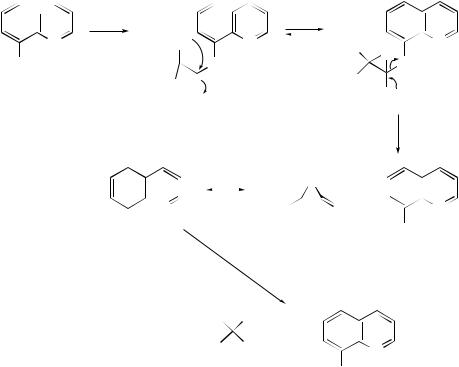

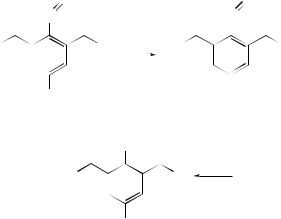
498 Organic Reaction Mechanisms 1998
transition states for the Wallach rearrangement.39 A study of the acid-catalysed benzidine rearrangement of unsymmetrical hydrazoaromatics has been undertaken, and the results have indicated40 the importance of disproportionations to understanding benzidine rearrangements.
Products isolated from the thermal fragmentation of N -arylbenzamide oximes and N -arylbenzamide O-phenylsulfonyl oximes have been accounted for by invoking
a free-radical mechanism which |
is |
initiated by the preferential homolysis of |
the N−O bond.41 Time-resolved |
IR |
spectroscopy has revealed that photolysis |
of N, N -dipheny1-1,5-dihydroxy-9,10-anthraquinone diimine affords acridinecondensed aromatic products via excited-state intramolecular proton transfer.42 The absolute and relative rates of thermal rearrangements of substituted benzyl isocyanides have been measured,43 and it has been found that the relative rates are independent of temperature and exhibit excellent Hammett correlations. Thionitrosoarene (25), thought to be generated by desulfurization of the stable N -thiosulfinylaniline (24), has been established44 as an intermediate in the formation of 3,3a-dihydro-2,1- benzisothiazole (26) from o-alkylthionitrosoarene (24).
|
|
S |
|
S |
|
|
|
|
|
|
|
|
|
|
|
S |
|
|
|
||
|
|
|
|
|
|
|
|
|
|
|
|||||||||||
|
|
|
|
|
|
|
|
|
|
|
|||||||||||
|
|
N |
|
|
|
|
|
|
|
|
|
|
|
|
|
N |
|
|
|
||
Ar |
|
But |
|
Ar |
Ar3P |
|
Ar |
|
But |
Ar |
|
||||||||||
|
|
||||||||||||||||||||
|
|
|
|
|
|
|
|
|
|
|
|
|
|
|
|
|
|
||||
|
|
|
|
|
|
|
|
|
|
|
|
|
|
|
|
|
|
||||
|
|
|
|
|
|
|
|
|
|
|
|
|
|
|
|
|
|
||||
(24) |
|
|
|
|
|
|
|
|
|
(25) |
|
|
|
||||||||
|
|
|
|
|
|
|
|
|
|
|
|
|
|
||||||||
|
|
|
|
|
|
N |
|
|
|
S |
|
|
|
|
|
||||||
|
|
|
|
|
|
|
|
|
|
||||||||||||
|
|
Ar |
|
|
|
|
|
|
|
|
|
Ar |
|
|
|
|
|
||||
|
|
|
But |
|
|
|
|
|
|
|
|||||||||||
|
|
|
|
|
|
|
|
|
|||||||||||||
|
|
|
|
|
|
|
|
|
|
|
|
|
|
|
|
||||||
|
|
|
|
|
|
|
|
|
|
|
|
|
|
|
|
||||||
|
|
|
(26) |
|
|
|
|
|
|
|
|
|
|
|
|
||||||
The pyrolysates obtained |
from the |
|
|
flash |
vacuum pyrolysis |
of the allyl esters |
|||||||||||||||
of a number of biphenyl carboxylic acids, biphenyldicarboxylic acids and biphenyldicarboxylic anhydrides have been examined by 1H NMR spectroscopy. In all cases the spectra showed the presence of cyclopent[a]indene and acenaphthylene with other products. On the basis of the findings the authors45 have postulated that hightemperature reactions of polycyclic aromatic hydrocarbons that result in the loss of two hydrogen atoms and formation of polycyclic hydrocarbons containing five-membered rings take place by loss of a sterically constricted hydrogen atom; this is followed by ring contraction of the resulting six-membered aryl radical, radical-induced
15 Molecular Rearrangements |
499 |
ring formation, loss of a second hydrogen atom and further rearrangement by interconversion of fiveand six-membered rings. On the other hand, pyrolytic reactions which result in the loss of the elements of acetylene from polycyclic aromatic hydrocarbons are considered to take place by loss of a hydrogen atom followed by ring contraction and radical-induced ring formation, loss of a second hydrogen atom followed by rearrangement of the rings, loss of a C2 fragment and hydrogen-atom shifts. Electronic structure studies have provided a wealth of information on the 1,2- didehydrogenation of polycyclic aromatic hydrocarbons and the ring contraction of the resulting arynes. The calculations have confirmed46 the experimentally postulated existence of a cyclopentadienylidene carbene in these processes. More recently, three distinct pyrolytic pathways connecting the thermally induced cyclodehydrogenation of 1-phenylnaphthalene to fluoranthene have been identified.47 The thermal conversion of 1-phenylbut-1-en-3-yne into its cyclo-isomerization products, viz. naphthalene, azulene, and 1-methylene-1H -indene, has been studied48 at high temperatures, while an investigation of the reactions on the C6H6 potential-energy surface has revealed that, although several mechanisms operate simultaneously, benzvalene is one of the key intermediates in the thermal intramolecular topomerization of benzene.49
Heterocyclic Derivatives
A novel transformation of N -alkoxycarbonylprolines to trifluoroacetyl-2,3- dihydropyrroles has been achieved50 by utilizing trifluoroacetic anhydride. A mesoinic 1,3-oxazolium-5-olate is thought to be the probable intermediate in this transformation.
The molecular mechanism for the pyrrole ring expansion to yield 3-chloropyridine as a model for the abnormal Reimer–Tiemann rearrangement has been characterized theoretically,51 while extensive rearrangement reactions, in particular ring expansions, have been observed for differently N -substituted 2,5-dimethylpyrroles under electron ionization.52 The rearrangements of model pyrrolenines carrying one or two pyrrolylmethyl groups at the disubstituted 2-position of the 3,4-disubstituted pyrrolenine ring have been investigated.53 The results have shown that the rearrangement of pyrrolylmethylpyrrolenines matches exactly that proposed for the porphyrin biosynthesis and occurs readily under both acid-catalysed and thermal conditions. By far the major route for the rearrangement is by a mechanism involving frag- mentation–recombination; indeed, it appears highly probable that this is the sole route; no evidence was found to implicate possible [1,5]-sigmatropic shifts in the process. A detailed investigation of the reaction path for the thermal rearrangement of 3,4-dihydro-1 αH-azirine[2,3-c]pyrrol-2-one to a cyanoketene–formaldimine complex has been carried out.54
A review of the indoledione–indole rearrangement has appeared.55 The photoirradiation of 1-ethoxy-2-phenylindole in methanol has been shown to afford 3- and 6-ethoxy-2-phenylindoles.56
An unexpected ring expansion of 5-isopropenyl-4,5-dihydrofuran-2,3-dicarboxylic acid (27) to 4,7-dihydro-6-methyloxepin-2,3-dicarboxylic anhydride (30) has been reported.57 The transformation is thought to proceed via anhydride (28) which is converted into the seven-membered oxepindicarboxylic anhydride (30) via (29) to
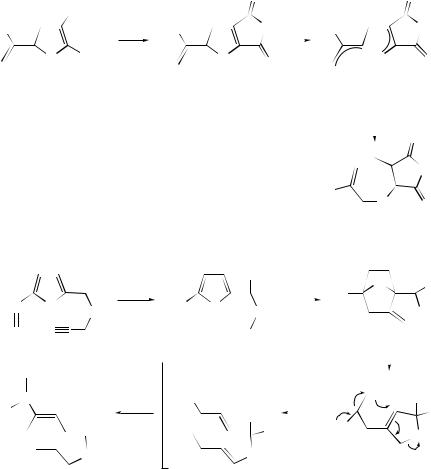
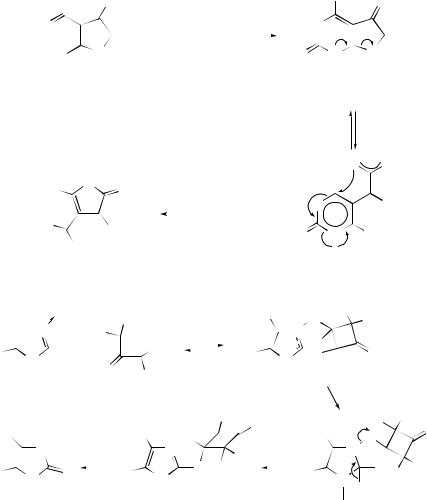
15 Molecular Rearrangements |
|
|
|
|
|
|
|
|
|
|
|
|
|
501 |
|||||||
Ph |
O |
|
|
|
|
|
|
|
|
|
|
|
Ph |
O |
|||||||
|
|
|
|
|
|
|
|
|
|
|
|
|
|
|
|
||||||
O |
|
|
|
|
O |
Me |
|
N |
|
C |
|
N |
|
Me |
O |
|
|
O |
|||
|
|
|
|
|
|
|
|||||||||||||||
|
|
|
|
|
|
|
|
|
|||||||||||||
|
|
|
|
|
|
|
|||||||||||||||
|
|
|
|
|
|
|
|
|
|
|
|
|
|
|
|
• • |
|
|
|||
|
|
|
O |
|
|
|
|
|
|
|
|
|
|
|
O |
||||||
Ph |
|
|
|
|
|
|
|
|
|
N |
N |
||||||||||
(31) |
|
|
|
|
|
|
|
|
|
|
|
|
|
|
|
Ph |
|
|
|
||
|
|
|
|
|
|
|
|
|
|
|
|
|
|
|
|
|
|
||||
|
|
|
|
|
|
|
|
|
|
|
|
Me |
Me |
|
|
|
|||||
|
|
|
|
|
|
|
|
|
|
|
|
|
|
|
|
|
(32) |
|
|
|
|
|
|
|
|
|
|
|
|
|
|
|
|
|
|
|
|
|
|
|
|
|
|
|
|
|
|
|
|
|
|
|
|
|
O |
− O |
|
|
|
|
|
|
|
O |
|
|
|
|
|
|
|
|
|
|
|
|
|
|
|
|
|
|
|
|
|
|
|
Ph |
|
|
|||
|
|
|
|
|
Ph |
|
O |
|
|
|
|
|
|
|
|
|
|
|
|
|
|
|
|
|
|
|
|
|
|
|
|
|
|
||
|
|
|
|
|
|
|
|
|
|
|
|
|
|
|
|
|
|
|
|
|
|
|
|
|
|
|
|
|
|
|
|
|
|
||
|
Me |
|
|
|
N |
|
|
O |
|
|
|
−Me |
|
N |
|
|
|
C |
|
|
O |
|
|
|
|
|
O |
+ |
|
O |
|
||||
|
|
|
|
|
|
|
|
|
|
|
|
|
|
|
|
|
|
|
|||||||||||||||||
|
|
|
|
|
|
|
|
|
|
|
|
|
|
|
|||||||||||||||||||||
|
|
|
|
|
|
|
|
|
|
|
|
|
|
|
|
|
|
|
|||||||||||||||||
|
|
|
|
|
|
|
|
|
|
|
|
|
|
|
|
|
|
|
|
|
|
|
|
|
|
|
|
Ph |
|
||||||
|
|
|
|
|
|
|
|
|
|
|
|
|
|
|
|
|
|
|
|
|
|
|
|
|
N |
N |
|
||||||||
|
|
|
|
|
|
|
|
|
|
|
|
|
|
|
|
|
|
|
|
|
|
|
|
|
|
||||||||||
|
|
|
|
|
|
|
|
|
|
|
|
|
|
|
|
|
|
|
|
|
|
|
|
|
|
|
|
||||||||
|
|
|
|
|
|
|
|
|
|
|
|
|
|
|
|
|
|
|
|
|
|
|
|
|
|
|
|
|
|
||||||
|
|
|
|
|
Ph |
|
|
|
|
|
|
|
|
|
|
|
|
|
|
|
|
|
|
|
|
|
|
|
|
|
|
|
|
||
|
|
|
|
(33) |
|
|
|
|
|
|
|
|
|
|
|
|
|
|
|
|
|
|
|
|
|
Me |
Me |
|
|
||||||
|
|
|
|
|
|
|
|
|
|
|
|
|
|
|
|
|
|
|
|
|
|
|
|
|
|
|
|
|
|
|
|
||||
R2 |
|
O |
|
|
|
Me |
|
X |
|
|
|
R2 |
|
O |
|
Me |
Me |
|
|||||||||||||||||
|
|
|
|
N |
|
Me |
|
|
|
|
|
|
|
|
|
|
|
|
|
|
|||||||||||||||
|
|
|
|
|
|
|
|
|
|
|
|
|
|
|
|
|
|
|
|
|
|
|
|
|
N |
|
|
|
|
|
|||||
R3 |
|
|
|
+ |
|
|
|
|
|
Me |
|
|
|
|
|
R3 |
+ |
|
−S |
|
|
|
O |
|
|||||||||||
|
|
|
|
|
|
|
|
|
|
|
|
|
|
|
|
||||||||||||||||||||
N |
|
|
|
|
|
|
|
|
|
|
|
|
|
|
|
Me |
|
|
|
|
|||||||||||||||
|
|
|
|
|
|
|
|
|
|
|
|
|
|
|
|
|
|
|
|
|
N |
|
|
Me |
|
||||||||||
|
|
|
|
|
S |
|
|
|
|
|
|
|
|
|
|
|
|
|
|
|
|
|
|
|
|
|
|
||||||||
|
|
|
|
|
|
|
|
Me |
|
|
|
|
|
|
|
|
|
|
|
|
|||||||||||||||
|
|
|
|
|
|
|
|
|
|
|
|
|
|
|
|
|
|
|
|
|
|
||||||||||||||
|
R1 |
|
|
X = O, S |
|
|
|
|
|
|
|
|
|
|
|
|
|
|
|
|
R1 |
|
|
|
|
|
|||||||||
|
|
|
|
|
|
|
|
|
|
|
|
|
|
|
|
|
|
|
|
|
|
|
|
|
|
|
|
|
|
|
|
|
|||
|
|
|
|
|
|
|
|
|
|
|
|
|
|
|
|
|
|
Me |
|
|
|
|
|
|
|
|
|
|
|
|
Me |
Me |
|||
|
2 |
|
|
|
|
|
|
|
|
R2 |
|
|
|
Me |
|
|
O |
|
|
|
|
|
R2 |
O |
|||||||||||
R |
|
|
|
|
|
|
|
|
|
|
|
|
|
|
|
|
|
|
O |
||||||||||||||||
|
|
|
|
|
|
|
|
|
|
HO |
|
|
|
|
|
|
|
|
|||||||||||||||||
|
|
|
|
NH |
|
|
|
|
|
|
|
N |
Me |
|
|
|
|
|
|
|
|
N |
|
|
|||||||||||
R3 |
|
|
|
|
|
|
|
|
R3 |
|
|
|
|
|
|
S Me |
|
|
|
|
R3 |
|
|
|
S Me Me |
||||||||||
N |
|
S |
|
|
|
|
|
|
|
|
|
|
|
|
|
|
|
|
|
|
|
||||||||||||||
|
|
|
|
|
|
|
|
|
|
|
|
|
|
|
|
|
|
|
|
||||||||||||||||
|
|
|
|
|
|
|
|
N |
|
|
|
|
|
|
|
|
|
|
N H |
|
|
||||||||||||||
|
|
|
|
|
|
|
|
|
|
|
|
|
|
|
|
|
|
|
|
|
|
|
|
|
|
|
|
|
|
|
|
|
|
||
|
R1 |
|
|
|
|
|
R1 |
|
|
|
|
|
|
|
|
|
|
R1 |
|
|
|||||||||||||||
SCHEME 16
α-Carboline has been obtained60 on pyrolysis of 1-benzylpyrazole in chloroform at 550 ◦C. 4-Benzoyl-5-hydroxy-3-trifluoromethylpyrazole derivatives have been synthesized by a new procedure61 which involves the rearrangement of the benzoyl group in 5-benzoyloxy-4-bromo-3-trifluoromethylpyrazole derivatives via lithium–bromide exchange using t -butyllithium.
It has been demonstrated that the reaction of azole N -oxides with cycloalkane thiones offers a simple and efficient route to azole-thiones.62 The described reaction sequence has subsequently been found to constitute a useful synthesis of imidazole- 2(3H )-thiones (see Scheme 16).

502 |
|
|
|
Organic Reaction Mechanisms 1998 |
|||
MeO2C |
|
|
H |
CO2Me |
CO2Me |
||
Cl |
|
|
|
||||
H |
( )n |
|
|
|
|
||
|
|
|
|
|
N |
|
|
O |
|
|
N |
|
|
|
|
|
|
|
|
||||
N |
|
|
• • O |
( )n |
|
||
|
|
|
|
Cl |
( )n |
||
|
|
|
|
|
|
O |
|
SCHEME 17
A new selective thermal cascade ring-enlargement process of 4-chloro-substituted spiro[cyclopropane-1,5 -isoxazolidines], leading to a new method for the synthesis of the indolizine skeleton, has been reported63 (see Scheme 17). Apparently, the process is made possible by the presence of a chlorine substituent on the carbon α to the spirocyclopropane ring which facilitates a cyclopropyl-to-cyclobutyl ring enlargement mediated by a polar solvent.
|
|
|
|
|
|
|
|
|
Ar′ |
|
|
|
||
|
SO2 |
|
−O |
O |
Ar′ |
|
Me |
|
|
N |
|
|
|
|
|
|
|
|
|
|
|
|
|||||||
|
|
|
|
|
|
|||||||||
|
|
|
|
|
|
|
|
|
|
|||||
Ar |
N |
+ |
|
+ |
|
|
|
Ar′ |
|
|
SO2 |
|||
|
|
|
||||||||||||
|
|
|
|
Ar′ |
N |
|
|
|
|
|
N |
|||
|
|
|
|
|
Me |
|
|
|
|
|
|
|
||
|
NEt2 |
|
|
|
|
|
|
|
|
Ar |
||||
|
|
|
|
|
|
|
|
|
|
|||||
|
(34) |
|
|
|
(35) |
|
|
|
|
|
|
|
|
NEt2 |
|
|
|
|
|
|
|
|
|
|
|
|
(36) |
||
|
Ar′ |
|
|
|
|
Ar′ |
|
|
|
|||||
|
|
|
|
|
|
|
|
|||||||
|
|
|
|
|
|
|
|
|||||||
|
|
|
|
Me |
|
|
N |
|
|
|
||||
|
|
|
|
|
CN |
|
|
|
|
|
|
SO2 |
||
|
|
|
|
|
|
|
|
|
|
|
||||
|
Me |
N |
|
|
|
|
|
|||||||
|
|
Ar |
|
|
Ar′ |
|
|
|||||||
|
|
|
|
|||||||||||
|
|
|
|
|
|
|
|
|
N |
|||||
|
|
|
|
|
|
|
|
|
|
|
|
|
|
|
|
|
|
Ar′ |
|
|
|
|
|
|
|
Ar |
|||
|
|
(38) |
|
|
|
|
|
|
|
|
|
NEt2 |
||
|
|
|
|
|
|
|
|
|
|
|
|
(37) |
||
In the presence of various metal ions, 2-(fluoroenone)benzothiazoline has been found to rearrange to N -2-mercaptophenylenimine,64 while a free radical mechanism involving the homolysis of C−S and C−N bonds has been invoked65 to explain the formation of 3-phenyl-1,2,4-triazole derivatives from the thermal fragmentation and rearrangement of 2-(arylidenehydrazino)-4-(5H )-thiazolone derivatives. The cycloadducts (36) formed from the reaction of 3-diethylamino-4-(4-methoxyphenyl)- 5-vinyl-isothiazole 1,1-dioxide (34) with nitric oxides or munchnones¨ (35) have been found66 to undergo pyrolytic transformation into α, β-unsaturated nitriles (38) by way of pyrrole–isothiazoline 1,1-dioxide intermediates (37).
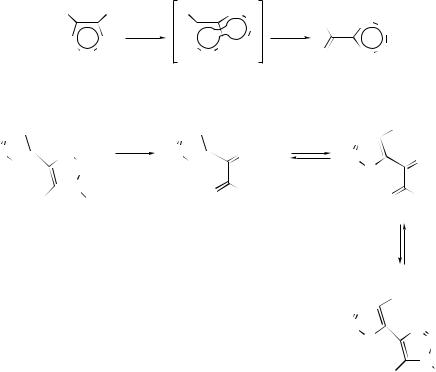

504 Organic Reaction Mechanisms 1998
A theoretical study of degenerate Boulton–Katritzky rearrangements concerning the anions of 3-formylamino-1,2,4-oxadiazole and 3-hydroxy-iminomethyl-1,2,5- oxadiazole has been carried out.72 The treatment has shown the participation of asymmetric transition states and non-concerted processes via symmetrical intermediates. A detailed ab initio and density functional study of the Boulton–Katritzky rearrangement of 4-nitrobenzofuroxan has indicated a one-step mechanism for the process.73
A study of the mechanism of the rearrangement of the oxide of a tertiary amine to the O-substituted hydroxylamine has been carried out by the semiempirical method AM1, using the N -oxide of N -(2,4-dinitrophenyl)piperidine as a model.74 It has been proposed75 that a benzidine rearrangement-type mechanism is the most likely mechanism for the acid-catalysed disproportionation of 4-[N -(4-hydroxyphenylhydrazino)]pyridine and 4-(N -phenylhydrazino)pyridine. A bimolecular mechanism involving an intermolecular transfer of the alkyl group, with inversion of configuration, to the N -oxide, followed by a second transfer of one of the alkyl groups of the cationic intermediate to one of the oxygens of the anionic intermediate, also with inversion of configuration, has been confirmed76 to account for the thermal rearrangement of 2-alkoxypyridine-1-oxides to 1-alkoxy-2-pyridones. The pyridine N -oxide-catalysed thione-to-thiol rearrangement of O,S-dialkyl xanthates has been analysed77 by semiempirical and ab initio molecular-orbital methods. The transition-structure analyses have indicated that the attack of pyridine N -oxide toward xanthates proceeds through an SN2 mechanism to give the dithiolcarbonate anion (42), which acts as actual catalyst (see Scheme 19).
|
|
|
|
|
|
|
|
|
|
|
|
+ −S |
|
C |
|
SMe |
|
MeS |
|
C |
|
SMe |
||||
|
|
|
|
|
|
|
|
|
|
|
|
|
|
|
|
|||||||||||
|
|
|
|
|
|
|
|
|
|
|
|
|
|
|
|
|
||||||||||
|
|
|
|
+ |
|
|
|
|
+ |
|
|
|
|
|
|
|
|
|
|
|
|
|
|
|||
|
|
|
|
|
N |
|
|
|
N |
|
|
|
|
|
|
|
|
|
|
|
|
|
||||
|
|
|
|
|
|
|
O |
|
|
|
O |
|||||||||||||||
|
|
|
|
|
|
|
|
|
|
|
|
|
|
|
|
|
||||||||||
|
|
|
|
|
|
|
|
|
|
|
|
|
|
(42) |
|
|
|
|
|
|
|
|
|
|||
|
|
|
|
|
O− |
|
|
|
OMe |
|
|
|
|
|
|
|
|
|
||||||||
Me |
|
O |
|
C |
|
SMe |
|
|
|
|
|
|
|
|
|
|
|
|
|
|||||||
|
|
|
|
|
|
|
|
|
|
|
|
|
|
|
|
|||||||||||
|
|
|
|
|
|
|
|
|
|
|
|
|
|
|
|
|
|
|
|
|
|
|
|
|
|
|
|
|
|
|
|
S |
|
|
|
|
|
|
|
|
|
|
|
|
|
|
|
|
|
|
|
||
|
|
|
|
|
|
|
|
|
|
|
|
SCHEME 19 |
|
|
|
|
|
|
|
|
|
|
|
|
|
|
1-Alkyl-1,4-dihydro-4-imino-3-quinolinecarboxylates have been found to undergo basic hydrolysis to afford the corresponding 1-alkyl-4-oxo-3-quinolinecarboxylic acids together with a variety of other rearranged products.78 Acridine has been obtained from the acid-catalysed rearrangement of N -aryl-2-vinyltetrahydro-4- oxoquinoline. A mechanism involving a retro-Michael process followed by the attack of the electron-rich aromatic ring on to the keto group has been proposed79 for the transformation. Upon thermolysis, 4-azido-2-oxoquinoline 3-carboxylates (43; X = NH) and 4-azidocoumarin-3-carboxylates (43; X = O) have been found

15 Molecular Rearrangements |
|
|
|
|
|
|
|
|
|
505 |
||||||
|
N3 |
|
|
|
|
|
N O |
|
|
|
|
N |
O |
|||
|
|
CO2R |
|
|
|
OR |
|
|
|
|
|
O |
||||
|
|
|
|
|
|
|
|
|
|
|||||||
|
|
|
|
|
|
|
|
|
|
|||||||
|
|
|
|
|
|
|
|
|
|
|
|
|
|
|||
|
|
|
|
|
|
|
|
|
|
|
|
|
|
|
||
|
|
|
|
|
|
|
|
|
|
|
|
|
|
|
|
|
|
|
|
|
|
|
|
|
|
|
|
|
|
|
|
||
|
X |
O |
|
|
X |
O |
|
X |
|
OR |
||||||
R′ |
|
|
|
R′ |
|
|
|
|
R′ |
|
|
|
||||
(43) |
|
|
|
|
|
(44) |
|
|
|
(45) |
|
|
|
|||
to cyclize to 3-alkoxyisoxazolo[4,3-c]quinolin-4(5H )-ones |
(44; X = NH) |
or the |
||||||||||||||
corresponding coumarins (44; |
X = O), |
whereas at slightly |
higher temperatures a |
|||||||||||||
3-O, 4-O rearrangement was |
found to |
occur, |
yielding the |
4-alkoxyisoxazolo[4,3- |
||||||||||||
c]quinolin-3-ones (45; X = NH) and the corresponding coumarins (45; X = O). The mechanism for the formation of (45) from (44) is assumed to involve a thermally allowed suprafacial [1,5]-sigmatropic rearrangement.80 1,2,3,5,6,10b-Hexahydro-8,9- dimethoxypyrrolo[2,1-a]isoquinolin-2-ones have been obtained from the reaction of 5,6-dimethoxy-3,4-dihydroisoquinoline N -oxide with diketene. The formation of these novel hexahydropyrrolo[2,1-a]isoquinolines has been proposed81 to arise via an initial cycloaddition reaction of the nitrone to the exocyclic double bond of diketene followed by a novel consecutive rearrangement involving NO bond cleavage rather than elimination of carbon dioxide. The cycloadducts (46) formed from isoquinolinium N -arylamides and acetylenic dipolarophiles have been found82 to undergo a [3,3]- sigmatropic rearrangement to yield a pentacyclic product (47), which on treatment with strong base furnishes 4-(o-aminophenyl)isoquinoline and methyl benzoylacetate (see Scheme 20).
1,7b-Disubstituted cyclopropa[c]isoquinolines (48) have been found to undergo the usual thermal rearrangement to yield 5-substituted 2-benzazepines (49). However, when R2 and R3 = H and either was an alkyl group, the reaction was found to divert into a new reaction pathway leading to the formation of 1,4-dihydro-4- alkenylisoquinolines (50) in high yield. It seems likely that these latter products are formed via a homo-[1,5]-sigmatropic hydrogen shift, a new mode of rearrangement for this system.83
New rearrangements of 2-imino-2H -1-benzopyran-3-carboxamides under the action of anthranilic acid as an N -nucleophile have been revealed.84 Depending on the conditions 2-(2-oxo-2H -1-benzopyran-2-yl)-3H -quinazolin-4-ones or 2-oxo-2H -1-benzo- pyran-3-(N -2-carboxyphenyl)carboxamides were found to be the products.
Reaction of the |
regioisomers |
of tetrahydrophosphinine |
oxide |
(51) |
with |
NaOH–H2O–CHCl3 |
under phase-transfer conditions was |
found |
to |
afford |
|
tetrahydrophosphepine |
oxides (52) |
through an unexpected |
path85 |
involving |
|
isomerization of (51) and cyclopropanation via Michael addition of −CCl3. (Scheme 21).
Advances in the Dimroth rearrangement in the adenine series have been reviewed.86 N -1-Methoxy derivatives of adenosine and 2 -deoxyadenosine have been found to

 NNHPh
NNHPh CO
CO R R
R R S
S


 R
R O
O

 N
N N N
N N
